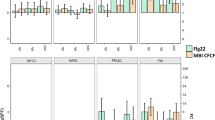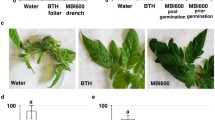Abstract
Many microorganisms interact with plants but information is insufficient concerning requirements for plant colonization and if interactions become beneficial or detrimental. Pretreatment of oilseed rape (Brassica napus) with Bacillus results in disease suppression upon challenge with pathogens. We have studied transcriptome effects on oilseed rape primed with the Bacillus amyloliquefaciens 5113 biocontrol strain and compared that with effects of the fungal pathogen Botrytis cinerea. Using the cDNA-AFLP technique 21,700 transcript fragments were obtained of which 120 were differentially expressed and verified by northern blot analysis for selected transcripts. Priming with Bacillus caused greater effect on leaf than root transcripts where sequencing and BLAST analysis suggested many of the transcripts to be involved in metabolism and bioenergy. Bacillus and Botrytis treatment also changed metabolic gene expression in addition to signaling and transcription control genes as well as a potential disease resistance (TIR-NBS-LRR) gene. The pathogen provoked non-primed plant profile was less dominated by metabolism than Bacillus and Bacillus–Botrytis treated plants. Several transcripts were homologues to unknown genes in the different treatments. Altogether Bacillus treatment of roots cause a systemic gene expression in leaves suggested to result in a metabolic reprogramming as a major event during priming.





Similar content being viewed by others
Abbreviations
- hpi:
-
Hours post inoculation
- ISR:
-
Induced systemic resistance
- JA:
-
Jasmonic acid
- LPS:
-
Lipopolysaccharides
- PGPR:
-
Plant Growth Promoting Rhizobacteria
- SA:
-
Salicylic acid
- SAR:
-
Systemic acquired resistance
- TDF:
-
Transcript derived fragment
References
Ahn P, Lee SW, Suh SC (2007) Rhizobacteria-induced priming in Arabidopsis is dependent on ethylene, jasmonic acid and NPR1. Mol Plant Microbe Interact 20:759–768. doi:10.1094/MPMI-20-7-0759
Altschul SF, Madden TL, Schaffer AA, Zhang J, Zhang Z, Miller W, Lipman DJ (1997) Gapped BLAST and PSI-BLAST: a new generation of protein database search programs. Nucleic Acids Res 25:3389–3402. doi:10.1093/nar/25.17.3389
Beckers GJM, Conrath U (2007) Priming for stress resistance: from the lab to the field. Curr Opin Plant Biol 10:424–431. doi:10.1016/j.pbi.2007.06.002
Benhamou N, Kloepper JW, Quadt-Hallman A, Tuzun S (1996) Induction of defense-related ultrastructural modifications in pea root tissues inoculated with endophytic bacteria. Plant Physiol 112:919–929
Bhalerao RP, Salchert K, Bako L, Ökresz L, Szabados L, Murakana T, Machida Y, Schell J, Koncz C (1999) Regulatory interaction of PRL1 WD protein with Arabidopsis SNF1-like protein kinases. Proc Natl Acad Sci USA 96:5322–5327. doi:10.1073/pnas.96.9.5322
Bloemberg GV, Lugtenberg BJJ (2001) Molecular basis of plant growth promotion and biocontrol by rhizobacteria. Curr Opin Plant Biol 4:343–350. doi:10.1016/S1369-5266(00)00183-7
Bostock RM (2005) Signal crosstalk and induced resistance: straddling the line between cost and benefit. Annu Rev Phytopathol 43:545–580. doi:10.1146/annurev.phyto.41.052002.095505
Breyne P, Dreesen R, Vandepoele K, De Veylder L, Van Breusegem F, Callewaert L, Rombauts S, Raes J, Cannoot B, Engler G, Inze D, Zabeau M (2002) Transcriptome analysis during cell division in plants. Proc Natl Acad Sci USA 99:14825–14830. doi:10.1073/pnas.222561199
Cartieaux F, Thibaud M-C, Zimmerli L, Lessard P, Sarrobert C, David P, Gerbaud A, Robaglia C, Somerville S, Nussaume L (2003) Transcriptome analysis of Arabidopsis colonized by a plant growth promoting rhizobacterium reveals a general effect on disease resistance. Plant J 36:177–188. doi:10.1046/j.1365-313X.2003.01867.x
Cartieaux F, Contesto C, Gallou A, Desbrosses G, Kopka J, Taconnat L, Renou JP, Touraine B (2008) Simultaneous interaction of Arabidopsis thaliana with Bradyrhizobium Sp. strain ORS278 and Pseudomonas syringae pv. tomato DC3000 leads to complex transcriptome changes. Mol Plant Microbe Interact 21:244–259. doi:10.1094/MPMI-21-2-0244
Chinni A, Fonseca S, Fernandez G, Adie B, Chico JM, Lorenzo O, Garcia-Casado G, Lopez-Vidriero I, Lozano FM, Ponce MR, Micol JL, Solano R (2007) The JAZ family of repressors is the missing link in jasmonate signaling. Nature 448:666–673. doi:10.1038/nature06006
Chomczynski P, Sacchi N (1987) Single-step method of RNA isolation by acid guanidinium thiocyanate-phenol-chloroform extraction. Anal Biochem 162:156–159. doi:10.1016/0003-2697(87)90021-2
Chung HS, Koo AJK, Gao X, Jayanty S, Thines B, Jones AD, Howe GA (2008) Regulation and function of Arabidopsis Jasmonate ZIM-Domain genes in response to wounding and herbivory. Proc Natl Acad Sci USA 146:952–964
Danielsson J, Reva O, Meijer J (2007) Protection of oilseed rape (Brassica napus) toward fungal pathogens by strains of plant-associated Bacillus amyloliquefaciens. Microb Ecol 54:134–140. doi:10.1007/s00248-006-9181-2
Denison RF, Kiers ET (2004) Lifestyle alternatives for rhizobia: mutualism, parasitism, and forgoing symbiosis. FEMS Microbiol Lett 237:187–193. doi:10.1111/j.1574-6968.2004.tb09695.x
Garbeva P, van Veen JA, van Elsas JD (2004) Microbial diversity in soil: selection microbial populations by plant and soil type and implications for disease suppressiveness. Annu Rev Phytopathol 42:243–270. doi:10.1146/annurev.phyto.42.012604.135455
Han SH, Lee SJ, Moon JH, Park KH, Yang KY, Cho BH, Kim KY, Kim YW, Lee MC, Anderson AJ, Kim YC (2006) GacS-Dependent production of 2R, 3R-butanediol by Pseudomonas chlororaphis O6 is a major determinant for eliciting systemic resistance against Erwinia carotovora but not against Pseudomonas syringae pv. tabaci in tobacco. Mol Plant Microbe Interact 19:924–930. doi:10.1094/MPMI-19-0924
Heil M (2001) The ecological concept of costs of induced systemic resistance (ISR). Eur J Plant Pathol 107:137–146. doi:10.1023/A:1008793009517
Idriss EE, Makarewicz O, Farouk A, Rosner K, Greiner R, Bochow H, Richter T, Borriss R (2002) Extracellular phytase activity of Bacillus amyloliquefaciens FZB45 contributes to its plant-growth-promoting effect. Microbiology 148:2097–2109
Kloepper JW, Ryu C-M, Zhang S (2004) Induced systemic resistance and promotion of plant growth by Bacillus spp. Phytopathology 94:1259–1266. doi:10.1094/PHYTO.2004.94.11.1259
Lopez-Bucio J, Cruz-Ramirez A, Herrera-Estrella L (2003) The role of nutrient availability in regulating root architecture. Curr Opin Plant Biol 6:280–287. doi:10.1016/S1369-5266(03)00035-9
Lucy M, Reed E, Glick BR (2004) Applications of free living plant growth-promoting rhizobacteria. Antonie Van Leeuwenhoek 86:1–25. doi:10.1023/B:ANTO.0000024903.10757.6e
Meharg AA, Killham K (1995) Loss of exudates from the roots of perennial ryegrass inoculated with a range of micro-organisms. Plant Soil 170:345–349. doi:10.1007/BF00010488
Newman M-A, Dow MJ, Molinaro A, Parrilli M (2007) Priming, induction and modulation of plant defence responses by bacterial lipopolysaccharides. J Endotoxin Res 13:69–84. doi:10.1177/0968051907079399
Ongena M, Jourdan E, Adam A, Paquot M, Brans A, Joris B, Arpigny JL, Thonart P (2007) Surfactin and fengycin lipopeptides of Bacillus subtilis as elicitors of induced systemic resistance in plants. Environ Microbiol 9:1084–1090. doi:10.1111/j.1462-2920.2006.01202.x
Penninckx IA, Eggermont K, Terras FR, Thomma BP, De Samblanx GW, Bucahala A, Metraux JP, Manners JM, Broekaert WF (1996) Pathogen induced systemic activation of a plant defensin gene in Arabidopsis follows a salicylic acid independent pathway. Plant Cell 8:2309–2323
Pieterse CMJ, Van Wees SCM, Hoffland E, Van Pelt JA, Van Loon LC (1996) Systemic resistance in Arabidopsis induced by biocontrol bacteria is independent of salicylic acid accumulation and pathogenesis-related gene expression. Plant Cell 8:1225–1237
Pieterse CMJ, Van Wees SCM, Ton J, Van Pelt JA, Van Loon LC (2002) Signaling in rhizobacteria-induced systemic resistance in Arabidopsis thaliana. Plant Biol 4:535–544. doi:10.1055/s-2002-35441
Pozo MJ, van der Ent S, van Loon LC, Pieterse CMJ (2008) Transcription factor MYC2 is involved in priming for enhanced defense during rhizobacteria-induced systemic resistance in Arabidopsis thaliana. New Phytol 180:511–523. doi:10.1111/j.1469-8137.2008.02578.x
Raaijmakers J, Vlami M, de Souza J (2002) Antibiotic production by bacterial biocontrol agents. Antonie Van Leeuwenhoek 81:537–547. doi:10.1023/A:1020501420831
Reva ON, Dixelius C, Meijer J, Priest FG (2004) Taxonomic characterization and plant colonizing abilities of some bacteria related to Bacillus amyloliquefaciens and Bacillus subtilis. FEMS Microbiol Ecol 48:249–259. doi:10.1016/j.femsec.2004.02.003
Ryu CM, Farag MA, Hu CH, Reddy MS, Kloepper JW, Paré PW (2004a) Bacterial volatiles induce systemic resistance in Arabidopsis. Plant Physiol 134:1017–1026. doi:10.1104/pp.103.026583
Ryu C-M, Murphy JF, Mysore KS, Kloepper JW (2004b) Plant growth-promoting rhizobacteria systemically protect Arabidopsis thaliana against Cucumber mosaic virus by a salicylic acid and NPR1-independent and jasmonic acid-dependent signaling pathway. Plant J 39:381–392. doi:10.1111/j.1365-313X.2004.02142.x
Sambrook JE, Fristsch F, Maniatis T (1989) Molecular cloning: a laboratory manual. Cold Spring Harbor Laboratory Press, Cold Spring Harbor, NY
Sarosh BR, Meijer J (2007) Transcriptional profiling by cDNA-AFLP reveals novel insights during methyl jasmonate, wounding and insect attack in Brassica napus. Plant Mol Biol 64:425–438. doi:10.1007/s11103-007-9164-9
Scheidler M, Schlaich NL, Felleberg K, Beissbarth T, Hauser NC, Vingron M, Slusarenko AJ, Hohesel JD (2002) Monitoring the switch from housekeeping to pathogen defence metabolism in Arabidopsis thaliana using cDNA arrays. J Biol Chem 277:10555–10561. doi:10.1074/jbc.M104863200
Schisler DA, Slininger PJ, Behle RW, Jackson MA (2004) Formulation of Bacillus spp. for biological control of plant diseases. Phytopathology 94:1267–1271. doi:10.1094/PHYTO.2004.94.11.1267
Thines B, Katsir L, Melotto M, Niu Y, Mandaokar A, Liu G, Nomura K, He SY, Howe GA, Browse J (2007) JAZ repressor proteins are targets of the SCF(COI1) complex during jasmonate signaling. Nature 448:661–666. doi:10.1038/nature05960
Uknes S, Mauch-Mani B, Moyer M, Potter S, Williams S, Dincher S, Chandler D, Slusarenko A, Ward E, Ryals J (1992) Acquired resistance in Arabidopsis. Plant Cell 4:645–656
van der Ent S, Verhagen WMS, van Doorn R, Bakker D, Verlaan GM, Pel MJ, Joosten RG, Proveniers MC, van Loon LC, Ton J, Pieterse CM (2008) MYB72 is required in early signaling steps of Rhizobacteria-Induced systemic resistance in Arabidopsis. Plant Physiol 146:1293–1304. doi:10.1104/pp.107.113829
van Hulten M, Pelser M, van Loon LC, Pieterse CM, Ton J (2006) Costs and benefits of priming for defense in Arabidopsis. Proc Natl Acad Sci USA 103:5602–5607. doi:10.1073/pnas.0510213103
van Loon LC, Bakker PAHM, Pieterse CMJ (1998) Systemic resistance induced by rhizosphere bacteria. Annu Rev Phytopathol 36:453–483. doi:10.1146/annurev.phyto.36.1.453
Verhagen BWM, Glazebrook J, Zhu T, Chang H-S, Van Loon LC, Pieterse CMK (2004) The transcriptome of rhizobacteria induced systemic resistance in Arabidopsis. Mol Plant Microbe Interact 17:895–908. doi:10.1094/MPMI.2004.17.8.895
Vos P, Hogers R, Bleeker M, Reijans M, Van de Lee T, Hornes M, Frijters A, Pot J, Peleman J, Kuper M, Zabeau M (1995) AFLP—a new technique for DNA fingerprinting. Nucleic Acids Res 23:4407–4414. doi:10.1093/nar/23.21.4407
Walker TS, Bais HP, Deziel E, Schweizer HP, Rahme LG, Fall R, Vivanco JM (2004) Pseudomonas aeruginosa-plant root interactions. pathogenicity, biofilm formation, and root exudation. Plant Physiol 134:320–331. doi:10.1104/pp.103.027888
Wang Y, Ohara Y, Nakayashiki H, Tosa Y, Mayama S (2005) Microarray analysis of the gene expression profile induced by the endophytic plant growth-promoting rhizobacteria, Pseudomonas fluorescens FPT9601-T5 in Arabidopsis. Mol Plant Microbe Interact 18:385–396. doi:10.1094/MPMI-18-0385
Yan Z, Reddy MS, Ryu C-M, McInroy JA, Wilson M, Kloepper JW (2002) Induced systemic resistance against tomato late blight elicited by plant growth-promoting rhizobacteria. Phytopathology 92:1329–1333. doi:10.1094/PHYTO.2002.92.12.1329
Zhang S, Reddy MS, Kloepper JW (2002) Development of assays for assessing induced systemic resistance by plant growth-promoting rhizobacteria against blue mold of tobacco. Biol Control 23:79–86. doi:10.1006/bcon.2001.0992
Zimmermann P, Hennig L, Gruissem W (2005) Gene-expression analysis and network discovery using Genevestigator. Trends Plant Sci 10:407–409. doi:10.1016/j.tplants.2005.07.003
Acknowledgements
This work was supported by grants from the IMOP programme SLU, Carl Tryggers fund, FORMAS, Nilsson-Ehle fund, Helge Ax:son Johnson fund, and Persson fund. We are grateful to Johanna Lagensjö and Namita Wadke for assistance in TDF cloning.
Author information
Authors and Affiliations
Corresponding author
Rights and permissions
About this article
Cite this article
Sarosh, B.R., Danielsson, J. & Meijer, J. Transcript profiling of oilseed rape (Brassica napus) primed for biocontrol differentiate genes involved in microbial interactions with beneficial Bacillus amyloliquefaciens from pathogenic Botrytis cinerea . Plant Mol Biol 70, 31–45 (2009). https://doi.org/10.1007/s11103-009-9455-4
Received:
Accepted:
Published:
Issue Date:
DOI: https://doi.org/10.1007/s11103-009-9455-4




